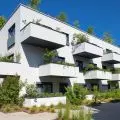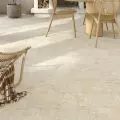Two investments that will transform the northern outskirts of Poznan's Old Town are taking off almost simultaneously. The first is the Museum of the Wielkopolska Uprising according to the winning design by WXCA. The second: the transformation of the neighboring Old Slaughterhouse - and in a less aggressive way than originally planned.
To the north of Poznan's Old Town, industrial areas and warehouses stretched throughout the 20th century . This was facilitated by the proximity of the river port on the Warta River and the Poznań Garbary railroad station with its numerous freight sidings. Industry began to withdraw from here in the 1990s, to - with the exception of the Farmapol pharmaceutical factory, which is still in operation today - disappear completely. What remains of many factories are uninteresting and partially demolished buildings. Instead, for more than a decade residential buildings have been growing here. More investments of this type are planned - most (about half a thousand) within the Old Slaughterhouse, located between Grochowe Łąki, Garbary, Północna and Wzgórzem św. Wojciecha streets. In turn, next to the Slaughterhouse, the Museum of the Wielkopolska Uprising is to be built on the site of the Bogdanka artificial ice rink.
Old Slaughterhouse in Poznan general view from the southwest - in the background, left: the hall, which was to be half demolished and replaced with apartment blocks, according to the new version of the plan, blocks will stand from this side only in place of two-thirds of the one-story hall complex in the foreground; the tree on the left side of the frame has already been cut down for the new road
Photo: Jakub Głaz
meatless for 23 years
The meat plant operated on Garbary Street for an equal hundred years. The very modern city slaughterhouse was opened in 1900. The complex of carefully designed buildings in neo-historical styles occupied more than five hectares of then suburban meadows. It was designed by Felix Moritz.
Old Slaughterhouse in Poznań General view of the slaughterhouse from the southeast - early 20th century
mat. investor
The plant survived the war in good condition. During the communist era, the old buildings grew with additions and new buildings of a purely utilitarian form (they were demolished three years ago). Production ended in 2000 and since then the slaughterhouse has stood empty. It has only been opened for antique fairs held here or occasional cultural events. The slaughterhouse is now in the hands of Vastint Polska, which - so far - has completed a correct complex of office buildings on Bulgarska Street in Poznań. It has also been planning for years to build the Portowo housing estate in Starołęka, but - despite declarations in June of this year - work has not yet begun.
We wrote in detail about Vastint's plans for Old Slaughterhouse more than a year ago. Let's recall in a nutshell: almost all of the historic buildings are to be renovated, revalued and adapted for new functions: retail, catering and cultural, among others. These old buildings are to be surrounded by seven-story residential buildings and (on the side of Północna and Garbary streets) - rather massive office buildings.
Old Slaughterhouse in Poznan mockup of the project from 2022, designed by JSK Architects Pszczulny & Rutz - at the back you can see a "wall" of three "investment fields" cluttered with blocks of flats, realization of the middle one will not be possible according to the new project mpzp, in this place a square with an uncut (as on the mockup) hall will be created
Photo: Jakub Glaz
Now, a year after the declared deadline, the investor announces that he is finally starting the renovation of the historic buildings. He is starting with one of the two buildings flanking the main entrance, on the corner of Garbary and Grochowe Łąki streets. In the past, it served the Slaughterhouse's commercial department, then was a company nursery. Now it will serve office and service functions. The work will be carried out by the ERBUD company. Next on the list for renovation is the second building at the entrance and the former gatehouse.
Old Slaughterhouse in Poznań visualization of the 2022 project, proj. JSK Architects Pszczulny & Rutz - view of the main entrance from Garbary Street, from this place the renovation of the old buildings will start
mat. investor, proj. JSK Architekci Pszczulny & Rutz
more and more adjustments
And how more precisely do the investor's intentions look today? One thing is known for sure: there must be a correction of the very detailed development plans (mock-up and visualizations) that Vastint showed in the fall of 2022. He did this despite the fact that work was still underway on the local zoning plan for Slaughterhouse and the eastern part of St. Adalbert's Hill. However, the project, prepared by Warsaw-based studio JSK Architekci Pszczulny & Rutz, did not arouse enthusiasm in Poznań. The office and residential blocks were judged to be over-scaled, as was the compact wall of massive buildings that visually and functionally separated the Slaughterhouse from St. Adalbert's Hill to the west and the site for the Wielkopolska Uprising Museum (more on that in a moment).
Thethree halls on the west side were also to be truncated (see the first photo e text). They were expanded several years after the plant opened, so the younger sections were considered worthless, despite the fact that they look exactly the same as the older parts of the buildings. In the face of criticism, the investor informed that such a shape of the investment is the result of arrangements with the City, and he sees no obstacles to the mpzp - which is in line with his intentions - being passed without major amendments.
Old Slaughterhouse in Poznań visualization of the 2022 project, designed by JSK Architekci Pszczulny & Rutz - on the right, a compact wall of buildings, which, according to the new provisions of the draft plan, will be "broken up" by a square with the hall preserved, in the foreground: Grochowe Łąki Street, in the background Cytadela Park
mat. investor, designed by JSK Architekci Pszczulny & Rutz
Fortunately, this will not be the case. Significant revisions are coming. After the presentation of the investor's exact intentions, the disclosure of the quality of its proposed new architecture, and an attempt to put Poznań residents before faits accomplis (very precise visualizations and a mock-up), the draft zoning plan began to be revised. The pro-investment provisions began to be trimmed by the Municipal Urban Planning Bureau itself, representatives of the Office of the Municipal Conservator of Monuments and the Department of Urban Planning and Architecture, among others, made their contribution to rectifying the situation. Poznan's SARP protested.
best change
Finally, nearly thirty comments to the plan (including some very significant ones) were submitted by the Municipal Urban Planning and Architectural Commission. At first, the mayor took into account only a few less significant comments, with no adjustments of fundamental importance. However, after the public display of the plan in October of this year, the accompanying discussion and the comments submitted on the draft, a very favorable change occurred. In the latest version of the draft mpzp, publicly displayed on December 22, the massive wall of three residential "fields" was broken down and the most valuable of the halls to be trimmed was preserved in its entirety. This created a functional and visual link in the form of a green square between the Slaughterhouse and the Hill and the planned Museum. From the Slaughterhouse one will have a good view of the Hill, the Museum and the park. Walking from the Hill, the historic buildings of the Slaughterhouse will be visible. A very good correction by the planners!
A fragment of the visualization for the mpzp for the Old Slaughterhouse - in the middle you can see the hall preserved in its entirety and the green square functionally connecting the Old Slaughterhouse with the park and the Museum of the Wielkopolska Uprising. In previous versions of the plan, a block of buildings of the same scale as the neighboring "investment fields" on the left and right were to stand in this place
Source: Miejska Pracownia Urbanistyczna, Poznań, www.mpu.pl
Unfortunately, the project still retains the new street surrounding Slaughterhouse (intended to connect Bóżnicza and Północna Streets), which will allow unwanted car transit right next to the park under the Hill. MKUA advocated cutting this road and replacing it with two reaches serving only the new residential area. To no avail. City officials declare that preventing transit will be possible through proper traffic organization, but the road is to be built anyway.
And, in fact, on Wednesday, December 27, the cutting of numerous trees and bushes in the lane for the new street began. In view of this accomplished fact, will the plan change yet? Discussion of the draft is scheduled for January 11, and comments can be submitted until February 9. Once the plan is passed, the developer is expected to move forward not only with renovations, but also with new construction. The entire development is expected to be ready by 2029 (we don't recall most of the visualizations from last year, because - in the face of the plan change - they too will have to change).
Local zoning plan in the area of Bóżnicza and Północna Streets in Poznań, part B, draft dated 22.12.2023 - on the right: the area of Stara Rzeźnia (1 MW/U), on the left: Wzgórze św. Wojciecha; bottom: Grochowe Łąki Street, top: Północna Street; the objects marked with a diagonal grid are historic buildings to be preserved, in the middle you can see a rectangular outline of the fully preserved hall with an accompanying green square on the left. This is the biggest and very beneficial change in the draft plan. Previously, there was a massive block of new construction at this location. The Wielkopolska Uprising Museum is marked with a U in a red field. The symbol 2ZP denotes a park with two designed green passages to St. Adalbert's Hill.
Source: Urban Planning Studio, Poznań, www.mpu.pl
Rising right next door
On the other hand, there is no mention of changes in either the development plan or the design for the Wielkopolska Uprising Museum. It will spring up right next to the Slaughterhouse, under St. Adalbert's Hill, on the site of the former Bogdanka artificial ice rink on Północna Street. Tomorrow, Friday, December 29, the tendered contractor, Adamietz, enters the construction site. Construction will finally begin according to the design by Warsaw-based studio WXCA, selected in the 2019 competition.
Museum of the Wielkopolska Uprising, winning design by WXCA studio (2019).
© WXCA
On the North Street side will stand four simple blocks composed freely around a semi-open courtyard. The buildings will be connected to each other underground. The concept for the permanent exhibition, also selected in a competition decided in September this year, is also ready. The winning design was made by the Trias AVI studio(we reported on this in a separate article).
Museum of Wielkopolska Uprising, winning design by WXCA studio (2019) - general view from the east over the Old Slaughterhouse, museum on the right, planned park at the foot of St. Adalbert's Hill in the middle.
© WXCA
From the south, a component of the museum will be a park, which will be built on a green area that is closed today. It remains to be hoped that the fine specimens of the trees growing wild here will be preserved , without replacing them with new "elegant" specimens. The entire museum project (building, exhibition and park) being implemented by the Wielkopolska Marshal's Office is expected to cost about 375 million zlotys. The opening is scheduled for December 2026.


























































